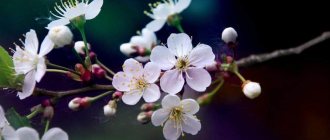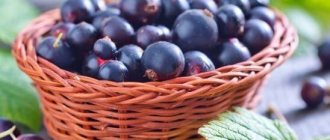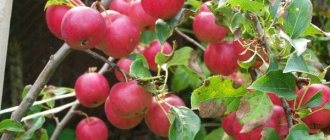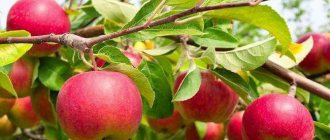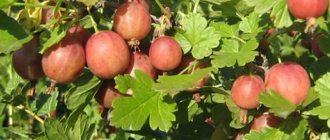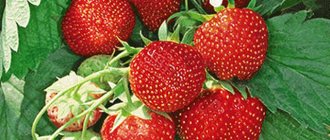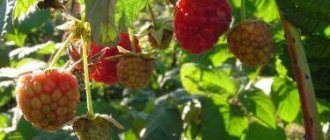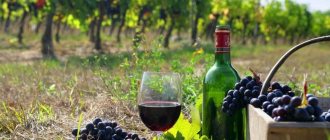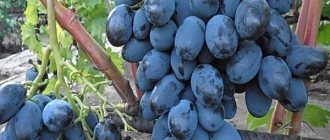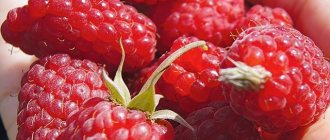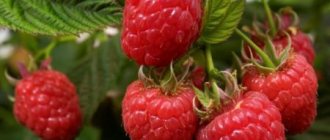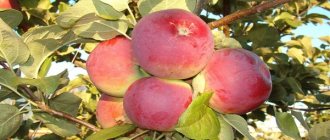The Rozhdestvenskoye apple tree is one of the new generation varieties of Russian selection. First of all, it attracts the interest of gardeners with its absolute resistance to scab, as well as its high yield and dessert taste of the fruit. We invite you to get acquainted with a detailed description of the Rozhdestvenskoye apple tree variety, as well as the specifics of its cultivation.
Triploid varieties of the crop are characterized by high stable yield and marketability of fruits
Let's start with the main characteristics of the variety shown in the table:
| Parameter | Characteristic |
| Culture | Apple tree (Malus domestica Borkh.) |
| Variety | "Rozhdestvenskoe" |
| Tree height | Medium height – 3-4 m (depending on the rootstock) |
| Precociousness | High – in the 4th year after vaccination |
| Period of (storage) consumption | Early winter - from mid-October to late January |
| Terms of removable (technical) maturity | Second ten days of September |
| Type of fruiting | Mainly on the rings |
| Productivity | High – 170-180 c/ha; up to 100 kg from one mature tree per season |
| Fruit weight | On average 140-180 g, maximum up to 200-250 g |
| Shape and color | The apples are round-conical, flattened, with slightly pronounced large lobes. The main color of the skin is green-yellow. Blurred red blush, with cherry-raspberry dots, covers almost the entire surface of the fruit |
| Fruit pulp | Light creamy, dense and juicy; with a sweet taste, slight sourness and a slight pleasant aroma |
| Tasting assessment (taste qualities) | 4.3 points (out of 5) |
| Purpose of fruits | Dessert |
| Sustainability | Immunity to scab of fruits and leaves (absolutely not susceptible to the disease), high frost resistance (at the level of “Antonovka vulgaris”), weak drought resistance |
| Year of inclusion in the State Register of the Russian Federation | 2001 |
| Recommended growing regions | Northwestern, Central, Central Black Earth, North Caucasian |
| Originator | Federal State Budgetary Institution "All-Russian Scientific Research Institute of Fruit Crop Breeding" (Oryol Region) |
Apple tree Rozhdestvenskoe
Trees of this variety reach medium size and are classified as fast-growing. They have dense, powerful branches and a gray trunk; the shoots are brown and of medium thickness.
Fruiting is observed on ringlets (in other words, on annual growths) with a highly developed apical bud. All this is taken into account when pruning.
Inflorescences consist of 4-6 flowers. The white and pink buds are umbrella-shaped. Flowers with rounded petals reach medium sizes.
The leaves are ovoid, pointed, medium pubescent, with their inherent dullness and wavy edges.
The weight of the fruit ranges from 140g to 180g and may vary in some years depending on weather conditions. The maximum weight of the fetus was recorded at 200g.
The presentation of apples deserves high praise The fruits of the Rozhdestveskoe variety are characterized by:
- Medium-thick, dense skin with a glossy sheen;
- Greenish-yellow color with cherry-red blush;
- Gray subcutaneous dots, large and numerous, are clearly visible;
- Thin, elongated stalks, located at an angle;
- The funnel is gray, shallow.
Fruits of the Rozhdestvenskoe apple tree.
Summarizing the description of the variety, it is worth saying that it is often found in the gardens of the country and abroad. It deserves special attention due to its combination of qualities, including taste.
Tasting qualities and chemical composition
The pulp of the fruit is dense, prickly, but at the same time juicy. Has a creamy tint. The taste is dessert, characterized by a harmonious combination of sweet and sour notes. The aroma is light, not pronounced.
Speaking about taste, breeders note the following percentage data:
- Sugar 10.4%;
- Titratable acids 0.48%;
- Pectin substances 14.1%;
- Sugar acid index 21.7%.
Important! Indicators and taste may vary depending on climatic conditions.
The overall tasting rating on a five-point scale reaches 4.3 points.
Advantages and disadvantages
Advantages of the variety:
- The main advantage of Rozhdestvensky is its absolute resistance to scab. Immunity to the disease is observed in both leaves and fruits;
- Presentation and dessert taste of fruits;
- Shelf life;
- High yield.
The following features counterbalance the impressive list of advantages :
- Non-simultaneous period of maturation;
- Tendency to fruit shedding;
- Deterioration in tasting qualities during long-term storage.
Tree height and crown width
The Rozhdestvenskoye apple tree is a medium-sized tree , reaching no more than 3 meters in height , with a regular wide-pyramidal crown.
It has several tiers of skeletal branches, each of which has up to five branches. The branches are located almost at right angles to the trunk. The tree is powerful , with flaky bark, the crown is medium dense.
Young apple trees "Rozhdestvenskoe".
The width of an adult apple tree reaches 2 meters in diameter. This should be taken into account when planting. Only after reaching these indicators will the tree produce maximum yield.
Annual growth
Every year the skeletal branches lengthen, and in the first years of life this process is much more rapid than in subsequent years. Thus, the growth of annual seedlings varies from 40 cm to 70 cm.
The crown of an adult, 20-25 year old tree reaches its full volume. Growth on such an apple tree is minimal and is activated with the help of anti-aging pruning.
Frequency of fruiting
"Rozhdestvenskoye" is characterized by regular fruiting. However, we recall that its frequency may be affected by a number of factors . Let's name a few main ones:
- The presence of an excessive number of ovaries on the tree - in this case, they will need to be thinned out, maintaining a distance of 10 cm;
- Untimely or insufficient application of fertilizers;
- Incorrect pruning;
- Presence of pests and diseases.
We should not forget about reasons beyond the control of the gardener, such as critical frosts, persistent rainy weather during the flowering period and other weather phenomena.
Productivity
The Rozhdestvenskoye apple tree variety is positioned as a promising hybrid and its yield is no exception to the list of advantages.
A young tree is capable of producing 180 c/ha of yield. The performance of older varieties is almost two times lower.
Drought resistance and winter hardiness
For many years, breeders have been working to increase the resistance of apple trees to temperature stress.
In the process of working on the Rozhdestvenskoye variety, scientists achieved high results. Trees that had undergone preliminary hardening were frozen to 40ºC in artificial climate chambers.
At the end of the experiment, damage to the buds and wood was found to be 1.5-1.7 points. For comparison, we note that the indicators of the control variety “ Antonovka ” froze on a scale of 1.0-1.5 points.
Speaking about drought resistance, let us remind you that this variety is medium-sized. Given the shallow root system, the tree needs additional moisture . The result of a lack of water supply can be:
- Slow growth;
- Shedding of fruits and leaves;
- Reducing the number of ovaries, which negatively affects productivity.
Attention! Dehydration of an apple tree in summer will affect its winter hardiness in winter.
Disease resistance
The main advantage of “Rozhdestvensky” is its absolute resistance to five races of scab.
This variety is indispensable for gardeners who prefer to grow varieties that are resistant to this disease rather than fighting it.
However, against the background of high immunity to scab , damage by pests such as aphids, leaf rollers, mites and others is not excluded
Watch a review of several varieties of apple trees (including Rozhdestvensky) in the video:
Taste qualities of the Rozhdestvenskoye apple variety
As noted by reviews, the varietal description and photo of Rozhdestvenskoye apples, the appearance and commercial quality of the fruit are always close to an excellent rating.
Main characteristics:
- glossy surface of the fruit;
- dense skin of medium thickness;
- green color with a yellow tint, cherry blush around the entire circumference of the fruit;
- the funnel at the stalk is medium depressed, gray in color;
- The pulp of the apples is cream-colored, juicy, and splitting.
The taste characteristics of Rozhdestvenskoye apples are rated by experts as 4.3 points out of 5 possible. The aroma of the fruit is light and unobtrusive. The taste is balanced in acidity and sweetness. The high percentage of sugars in the composition (more than 10%) allows us to classify the variety as dessert.
Attention! The taste characteristics of the fruits of the Rozhdestvenskoye apple tree vary greatly, depending on the composition of the soil and weather conditions.
When storing harvested crops, the characteristics decrease after a few months. The sweetness noticeably decreases, and the pulp becomes loose.
The Rozhdestvensky variety has a high pectin content: more than 14%. This makes it easy to gel products made from the fruit. Marmalades, jam, and apple marmalade are thick and transparent with minimal processing. The fruits are used for canning compotes and making juices. But the main purpose of dessert apple fruits is fresh consumption.
Reviews
Tamara S, Orel. “I value the Rozhdestvenskoye variety, first of all, for its resistance to scab. It does not need treatment for this disease and the apples we collect are environmentally friendly and tasty compared to others! I make pies for the children, make jams, and they eat them fresh!”
Yuri V, Moscow region. “They’re not bad apples, but I think it’s better not to plant them in unfavorable areas; the variety is still zoned in the central Black Earth region”
Leonid K, Krasnodar. “I like Rozhdestvenskoe and it’s easy to care for – you don’t need to spray it for scab, they’re both beautiful and tasty. They are stored well. In January they lie juicy, although not as sweet as in the fall.”
Olga O, Tambov. “Rozhdestvensky, in my opinion, has a slightly sour taste; you can’t eat much, but on the other hand, the caramel notes are very pronounced, and most importantly – juicy and crispy!”
Irina U, St. Petersburg. “I once had the idea to create an apple orchard on a trellis. I spent a long time choosing, consulting, and, after listening to experts, I chose “Rozhdestvenskoye” for such an experiment. I want to say that I am satisfied with the result. Satisfied with taste and yield. In addition, it is very convenient to cover for the winter. It’s still cool here for apple trees.”
Harvesting and storage
The harvest of apples of the variety in question begins in early or mid-September, when the fruits reach full ripeness. Unlike some other varieties, Rozhdestvenskoe does not require a long period of aging and can be eaten immediately after harvesting, revealing all its qualities to the maximum.
For harvesting, choose only a windless day without precipitation, so that all harvested apples are completely dry. You should not tear off the stalks, and before storing them in the cellar, it is better to immediately sort the apples by size and ripeness, removing spoiled or damaged fruits. If possible, cool the apples or try to at least ventilate them in the fresh air, avoiding exposure to moisture: within 2–3 weeks, defective fruits will appear, which should be removed immediately so that the rot does not spread.
For long-term storage, healthy specimens are wrapped in soft paper and, placed in boxes with the stem facing up, taken to storage at a temperature within +1...+2°C. These are the values that are considered ideal for the comfortable location of Rozhdestvenskoe apples and the long-term preservation of all their properties.
In general, the described variety can be considered as one of the most suitable options for cultivation in most of Russia and neighboring countries: the trees are relatively unpretentious in care and always delight with stable yields of tasty and juicy fruits of universal use.
Landing
Deadlines
With the advent of seedlings with a closed root system, gardeners practice year-round planting . However, two main methods are most justified:
- Autumn - after the leaves fall, in mid-October . The seedling has time to adapt and recover before the first frost;
- Spring - before buds open. This planting is recommended in areas with harsh climates, from -30...-20°.
When planting in spring, seedlings need abundant watering , the lack of which will lead to various diseases and slow growth.
When planting in spring, seedlings are well watered.
Description of the tree
Apple trees have a compact, neat appearance and strong, powerful main branches.
Weakly kneeled, strong shoots are located at an angle of 45-80 degrees to the trunk and form a wide-pyramidal, medium-leaved crown. The leaves are ovate, with a curled, pointed tip and a wavy, serrated edge. The leaf blade is slightly pubescent, matte, green. White and pink buds are collected in 4-6 pieces in umbrella-shaped inflorescences.
Driving around the expanses of the country, in many gardens you can observe the presence of a tree such as an apple tree. “Rozhdestvenskoe”, a full description of the variety is given in the article, is no less common than the same “Antonovka”. If we talk about the tree itself, then each variety differs in the size of the crown, the height of the tree, and the nature of the roots. This is important for those people who calculate the garden area by meters and want to plant it as densely as possible.
What you need to know about this type of tree:
- They are distinguished by a stem of medium height, while a young one-year-old tree grows about seventy centimeters annually.
- The crown has the shape of a cone, is not distinguished by abundant foliage, and has good strength indicators.
- The main stem has a powerful appearance, and side branches diverge from it at an angle.
- All branches are covered with rough gray bark.
- The leaves strongly resemble the shape of an egg, with wavy edges and a pointed tip. In principle, the type of leaves is of more interest to those who want not to make a mistake in choosing a seedling. For landing calculations, the crown characteristic has more weight.
Each apple variety has its own taste and external characteristics that make it unique and distinguish it from others. The Rozhdestvenskoe apple is a winter variety. The harvest is harvested in early autumn and stored well in a cool room, such as a cellar, for a long time.
The Rozhdestvenskoye apple tree has a fast growth rate. In just a few years, annual seedlings reach a growth height of 40-70 cm. Description of structural features:
- Crown. Durable, wide pyramidal, medium leafy.
- Branches. The tree has strong main branches growing at an angle of about 80°, with gray flaky bark.
- Escape. Thickened, brown in color, slightly pubescent, round in cross-section.
- Kidneys. Pressed, have a conical shape and edge.
- Leaves. Egg-shaped with wavy edges, matte green color. The leaf blade is wrinkled and has a pubescent edge.
- Inflorescences. The apple tree has abundant color with large umbrella-shaped inflorescences of 4-6 large round petals of pale pink color.
Rozhdestvenskoye apple in the palm Branch of a Rozhdestvenskoye apple tree with fruits The size of Rozhdestvenskoe apples relative to a matchbox
Agricultural technology
To plant a seedling, you need pre-prepared equipment and a sequence of actions:
- When digging a hole with a diameter of 80-100 cm, the top fertile layer of soil is laid in one direction, the subsequent ones in the other;
- Having reached a depth of 60 cm, the bottom is loosened and a stake is installed in the center;
- A mixture of compost (5-8 kg), peat with superphosphate (80-100g) and potassium salt (35-45g) is poured onto the bottom of the hole, forming a hill;
- The seedling is installed, distributing the roots, and tied to a support;
- Cover with fertile soil, forming a cushion and water abundantly.
Important! The key to success in planting and adapting a seedling will be a prepared hole.
Let us remind you that the variety “Rozhdestvenskoe” is medium-sized . Therefore, the optimal distance between trees is 3-3.5 m.
What benefits does the apple tree give us?
“Rozhdestvenskoe” (description, photo, reviews of which you see here) has not only excellent taste. The tree can rightfully be considered useful thanks to the substances contained in the apple.
Experts who assess the composition of fruits have given the following data on the chemical composition of the fruit:
- Sugar-acid index – 16-22 (depending on the area where the tree is grown).
- Pectin substances – 14%.
- Sugar – 10%.
- Titrated substances – 0.5%.
Such data will tell knowledgeable people about the quality of the fruit better than any photo of an apple. For those who know little about chemistry, it is enough to see and taste an apple to make a choice in favor of this variety.
Growing
Let us highlight three most important aspects in growing an apple tree.
Fertilizer
In the first year, the seedling needs enough fertilizer applied during planting. In the future, you should be guided by the following scheme:
- Autumn fertilizer involves the introduction of potassium compounds, superphosphates and organic matter for digging ;
- Spring care involves enriching the soil with nitrogen . In this case, 2/3 of the composition is added before the buds open, the rest is replenished after flowering.
In the first years after planting, nutrients are applied no deeper than 15 cm. Starting from the third year, they are deepened to 50 cm, retreating from the trunk by 1.5 m.
Watering
The frequency of watering is adjusted by climatic conditions . As for the quantity, there is an opinion among experienced gardeners: “No matter how old the apple tree is, how many buckets of water will be needed for watering.”
Trimming
directly depends on pruning and it is carried out all year round at certain times. The technology depends on the type of rootstock, age and climate.
Pruning is one of the most important agricultural techniques.
Let's briefly talk about the main types of this procedure:
- Autumn pruning is carried out after the leaves have fallen and is aimed mainly at removing old, diseased or broken branches;
- The purpose of spring pruning is to help the tree enter the growing season. This period is recommended for rejuvenation, as well as thinning and crown formation.
The result of proper pruning will be high yields, the growth of healthy shoots and a reduction in tree height.
Pollinator varieties
Cross-pollination is possible under the condition of simultaneous annual flowering of “Rozhdestvensky” and pollinating varieties . The distance between trees is also important; it should not exceed 50 m.
Botanical description
The medium-sized tree has a wide pyramidal crown.
Strong main branches extend from the trunk at an angle of about 70-80 degrees. The stem is gray in color, with flaky bark. The seedlings are characterized by intensive growth (60-70 cm), especially in the first years. After 2-3 years, their growth slows down significantly.
The shoots are of medium thickness, slightly drooping (geniculate). They are round in cross section, have a brown color and are covered with fine fluff. The buds are tightly pressed, with villi, and cone-shaped.
The leaves are green, oval, with a short pointed edge, wavy. There are teeth along the contour, the tops are screw-shaped. The foliage is slightly wrinkled and matte.
Delicate pink flowers are collected in umbrella inflorescences of 5 buds. When in bloom, their petals have a round shape. The inflorescences themselves are large and, judging by the description, photos, reviews, the “Christmas” apple tree blooms very profusely.
Features of ripening, flowering and fruiting
From the moment of planting “Rozhdestvensky” to the ripening of the first fruits, as a rule, no more than four years .
It is difficult to say unambiguously about the flowering time; it depends on climatic conditions. However, the middle and second half of May are the most typical period.
Fruiting of 3-year-old trees of the Rozhdestvenskoye variety on a medium-sized rootstock.
“Rozhdestvenskoe” is an early winter variety , so the fruits are harvested at the end of September. One of the disadvantages of apple trees is that they do not ripen at the same time. Winter varieties are characterized by longer shelf life.
There is a possibility of long-term storage of this variety , until next year. But over time, the fruits become much less sweet and juicy.
Advantages and disadvantages of the variety
The Rozhdestvenskoye apple tree variety has both positive and negative properties. Its advantages include:
- high productivity;
- good keeping quality of fruits;
- high transportability;
- marketable condition;
- apple trees are undemanding in care;
- high immunity;
- good taste of apples;
- good frost resistance of apple trees.
The disadvantages of apple trees of the Rozhdestvenskoye variety are the extended period of fruit ripening, as well as their tendency to shed at the end of the fruiting period. By the end of their shelf life, fresh apples lose their flavor and become soft.
Different types of rootstocks
The most optimal rootstock for this variety is of two main types.
Dwarf and semi-dwarf
This is a rootstock with restrained growth. The tree reaches up to 3m in height , the crown width does not exceed 2m and has a superficial root system. In view of the latter, do not forget about low frost resistance. As a rule, the tree does not survive temperatures below –15 ° C ; careful wrapping will help prevent its death.
Rozhdestvenskoye apple tree on a dwarf rootstock.
Columnar
There is no variety of columnar apple tree Rozhdestvenskoe, so we will give brief information about columnar apple trees in general.
Such apple trees will be a solution for owners of small plots. The trees do not have skeletal branches, grow in one trunk and occupy no more than 20-30 cm . The recommended planting distance is 50 cm between columns and up to 9 cm between rows.
Important! The beginning of fruiting of columnar apple trees can be expected in the second year after planting, however, the period of fruiting of the tree is half that of ordinary vigorous apple trees.
Agrotechnical recommendations
Due to the presence of the Vf gene, the fruits and leaves of the variety are absolutely resistant to all existing races of scab (Venturia inaequalis).
The frost resistance indicators of the Rozhdestvenskoye apple tree are quite high: for example, after artificial freezing at temperatures down to −40 ℃, only minor damage to the buds and bark was noted. However, the tree's overall winter hardiness is average; moreover, on a dwarf rootstock in winter, the roots located close to the soil surface may freeze. Accordingly, when planting in the northern regions and the Urals, plants need careful insulation.
During dry periods it is important to ensure regular watering of trees
In reviews of the Rozhdestvenskoye apple tree, gardeners note that the variety does not tolerate drought well - the tree loses its leaves, its productivity decreases sharply, so timely watering is especially important in hot years. In addition, it is advisable to purchase seedlings from local nurseries that provide maximum adaptation to climatic conditions.
An apple tree can be damaged by insect pests: the most dangerous are codling moths, aphids, spider mites, bark beetles, and scale insects. To protect the tree, a number of insecticide treatments will be required:
| Growing season | A drug |
| Before the buds swell | Copper sulfate solution, “DNOC” |
| After the leaves appear | "Carbamide", "Nitrophen", Bordeaux mixture |
| During budding and after flowering | "Benzophosphate", "Chlorophos" |
| During fruit formation | "Topaz", "Match" |
| After the leaves fall | Iron sulfate solution, "Urea" |
The variety is suitable for growing on a trellis.
Due to the high yield and at the same time the relative compactness of the plant, the Rozhdestvenskoye variety can be an excellent choice for planting even in a small area. The main thing is to follow the basic rules of tree care and remember to protect it from pests.
Cultivation in some regions
The Moscow region is famous for its changeable climate. At the same time, this variety is susceptible to sudden changes in temperature. The apple tree is suitable for growing in this region, but it is better to be on the safe side and wrap the trunk for the winter.
In the Moscow region, the trunk of an apple tree is wrapped for the winter.
As for the Volga region , this territory is ideal for planting and growing “Rozhdestvensky”, but subject to frequent and thorough watering.
Breeders talk about the high winter hardiness of the variety with a certain hardening of the apple tree. The experience of amateur gardeners is often not enough to grow apple trees in harsh climates, so “Rozhdestvenskoe” is not recommended for planting in the Urals or Siberia.
Origin and zoning
The variety was obtained in 1985 at the All-Russian Research Institute for Breeding Fruit Crops by crossing the Welsey apple tree with the hybrid BM 41497. The new variety became triploid, that is, it received a triple set of chromosomes, which provided it with greater endurance and productivity.
The authors of the variety are E. N. Sedov, Z. M. Serova, V. V. Zhdanov, E. A. Dolmatov and G. A. Sedysheva.
Testing of the Rozhdestvenskoye apple tree began in 1999; in 2001 it was included in the State Register of the Russian Federation as recommended for the Central and Central Black Earth regions. Growing is also possible in the North Caucasus and North-Western regions, but in the second case the plant will need insulation for the winter. Provided that it is watered regularly, this apple tree is also suitable for the Volga region.
The rights to distribute the variety are protected by a patent - they belong only to the originator and licensed producers
Place of birth of the variety: All-Russian Research Institute for Breeding Fruit Crops
The All-Russian Research Institute for Breeding Fruit Crops is the oldest horticultural institution in Russia. In 2010, the institute celebrated its 165th anniversary (the official founding date was April 28, 1845).
Plant gene pool
The Institute has one of the largest gene pools of fruit plants in the country, which includes 6,618 varieties and 76,575 hybrid seedlings, 85 species in 12 crops and is annually replenished with new varieties, selected forms and species. He is the main supplier of new apple varieties in central Russia. Apple breeders are working to create new varieties with high adaptability, productivity, regular fruiting, and fruits rich in nutrients and biologically active substances. Among the priority areas of selection are immunity and high plant resistance to diseases and pests
Program "Immunity"
The goal of the program is to create competitive apple tree varieties that are immune to scab (with the main resistance genes). The most harmful disease of apple trees in central Russia is scab (Venturia inaequalis). The reduction in apple yield in the middle zone due to scab damage is at least 40%, and in some years reaches 70-80%. A targeted large-scale breeding program for the development of apple tree varieties immune to scab has been carried out at the institute since 1976. After studying the world collection of varieties, numerous crossings and cullings, more than 60 thousand hybrid seedlings were planted in breeding gardens, on the basis of which VNIISPK created the first domestic apple tree varieties immune to scab in Russia. Currently, VNIISPK has created more than 20 scab-immune (with the Vf gene) apple tree varieties, 16 of which are included in the State Register of Breeding Achievements approved for use. The best of them: Yablochny Spas, Solnyshko, Bolotovskoye, Imrus, Freshness, Rozhdestvenskoye, Kandil Orlovsky, Venyaminovskoye. The VNIISPK initiative to create apple tree varieties genetically resistant to scab has been supported by a number of other breeding institutions in Russia.
Apple tree varieties immune to scab, bred by VNIISPK, included in the State Register of the Russian Federation
Variety name
[/td]
| Ripening period | Fruit shelf life | Average yield, t/ha | Fruit weight, g | Appearance of fruits, score | Fruit taste, score | |
| Aphrodite | r-z | until the end of December | 22 | 130 | 4,4 | 4,4 |
| Bolotovskoe | h | until February | 24 | 150 | 4,3 | 4,5 |
| Venyaminovskoe | h | until the end of February | 20 | 130 | 4,5 | 4,4 |
| Health | h | until mid-February | 23 | 140 | 4,3 | 4,3 |
| Imrus | h | until the end of February | 20 | 140 | 4,3 | 4,4 |
| Kandil Orlovsky | h | until February | 28 | 120 | 4,4 | 4,3 |
| Kurnakovskoe | h | until mid-February | 19 | 130 | 4,3 | 4,3 |
| Oryol Polesie | r-z | until mid-January | 23 | 140 | 4,4 | 4,3 |
| In memory of Khitrovo | h | until the end of February | 18 | 170 | 4,3 | 4,3 |
| Rozhdestvenskoe | h | until the end of January | 20 | 140 | 4,4 | 4,5 |
| Freshness | p-z | I'm at home | 23 | 140 | 4,3 | 4,2 |
| Sun | By | till December | 22 | 140 | 4,4 | 4,3 |
| Start | h | until the end of February | 22 | 140 | 4,3 | 4,3 |
| Stroevskoe | h | until the end of February | 21 | 120 | 4,5 | 4,4 |
| Moscow anniversary | h | until the end of February | 21 | 120 | 4,3 | 4,3 |
| Jubilee | p-l | until the end of September | 13 | 130 | 4,4 | 4,3 |
| Apple Spas | l | until the end of September | 20 | 200 | 4,4 | 4,3 |
| Note: l – summer, p-l – late summer, p-o – late autumn, h – winter, r-z – early winter, p-z – late winter. | ||||||
